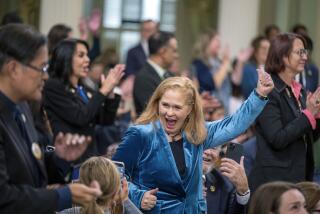Opportunity knocks
- Share via
California’s voting districts are redrawn every 10 years, when new census figures are released. Anyone with the population data and a home computer could easily draw maps of evenly populated districts. One map is needed to show the four new districts of the Board of Equalization, the state’s elected tax commission. A second would redivide California into 40 state Senate districts, a third into 80 Assembly seats, a fourth into 53 congressional districts. How hard could it be?
Hard enough. To make sure that the redrawn lines enhance rather than diminish their faction’s clout in Congress or the Legislature, Democratic and Republican party leaders put themselves in control of the process and wrangle. Republicans were in charge for decades and did their best to guarantee themselves a perpetual voting advantage. Democrats, who now hold the reins, do the same.
Party leaders are comfortable divvying up districts as long as there is no interference from outsiders, like the public. That way, they can guarantee safe seats for incumbents and award future seats to party lieutenants who toe the line on favorite legislation and raise lots of campaign cash for party coffers.
That party duopoly makes politics an inside game played with rules that work in the best interests of politicians, but not always for the people they are supposed to serve. Seats that are clearly weighted to one party or the other tend to get Republicans who are more conservative, or Democrats who are more liberal, than the typical voter, and that in turn creates an ultra-partisan Legislature that gets little done for California’s generally centrist population.
It is one of those internally reinforcing political mechanisms that resist well-meaning reform efforts, which is why it goes on, decade after decade. But this year, for a series of politically amusing reasons, may be just the time to start over. Assembly Speaker Fabian Nuñez (D-Los Angeles) and Senate President Pro Tem Don Perata (D-Oakland) are about to be termed out, but they’re not ready to go. They want voters to approve a measure to loosen term limits. They need that measure to pass well before June, when they would be running for their extra terms. California has moved up its presidential primary to February, giving politicians a new ballot in which they can place a term-limits measure. But Gov. Arnold Schwarzenegger promises not to support any such measure without allowing voters at the same time to revamp districting. So here we are. Lawmakers are motivated to make redistricting reform work.
That creates a rare opportunity, and one that presents several important questions:
* Who draws the lines? Some proposals call for a variation on the grand jury, in which names are drawn from voter lists and finalists are chosen by the governor and leaders of both parties from both houses of the Legislature. Nuñez’s plan calls for picks from the parties, balanced by a slim majority of appointments by judges. The ideal may be somewhere in between. It may be naive to expect random Californians to be enthusiastic about drawing district lines, but the Nuñez plan still awards too much clout to party leaders.
* What lines are drawn? Perata says Congress must be excluded because he won’t preside over a revamp that deprives Rep. Nancy Pelosi of the House speakership and Democrats of their congressional majority -- especially when states such as Texas and Florida are keeping their Republican majorities in charge of their reapportionments. One compromise being floated is to include Congress, but not until the 2021 redistricting. That’s a perpetual delay tactic. Unlike cynical Republican plans to end winner-take-all primaries in order to peel off some of California’s electoral votes, honest redistricting does not disenfranchise voters here and, in fact, sets the standard for other states to follow. Congress should be included in the revamp right away.
* Who gets credit? In Sacramento, the inability to agree on the answer to this question often kills progress. Lawmakers have a couple of days to agree on a final plan to put before voters next year. If they can’t, they will have to learn to live with the initiatives that take all power out of their hands.
More to Read
Get the L.A. Times Politics newsletter
Deeply reported insights into legislation, politics and policy from Sacramento, Washington and beyond. In your inbox twice per week.
You may occasionally receive promotional content from the Los Angeles Times.








